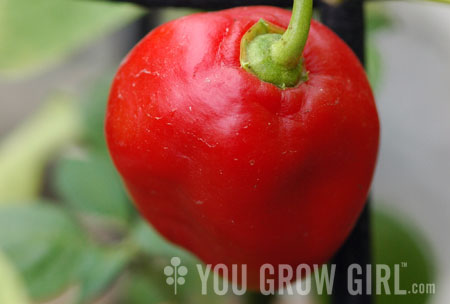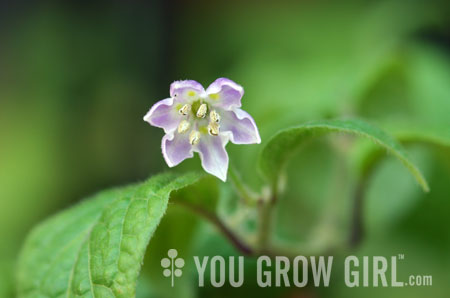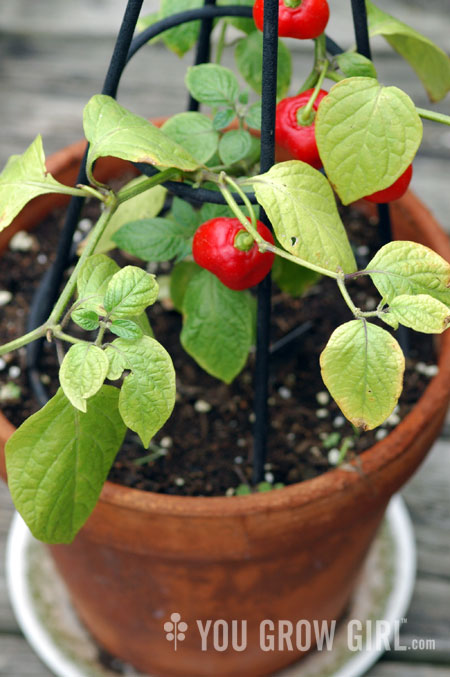
Last winter while digging through seed catalogues for new plants to buy I came across a hot pepper variety that I could not resist trying. Actually, I came upon several irresistible hot pepper varieties. As someone who doesn’t actually eat hot peppers I sure do grow a lot of them. As an edible plant they’re just so captivating with countless options to choose from. And because hot peppers have a historically significant human connection, having been important to cultures around the world for thousands of years, they often come with a good story attached. I can not resist a good story.
I particularly lean towards plants with variegated foliage since they are attractive all season long, adding colour and interest when tucked in among plain ole’ green basil and lettuce varieties.
Growing hot peppers is a challenge I’ve had a lot of success with, a plant whose code I’ve mostly cracked. When I find one that is a bit different I can’t resist the need to experience it firsthand. I have to know! How will it grow in a container? What size container does it need? What kind of yield can I get? On and on and on. There are lots of questions. It’s the work involved in finding answers to mostly geeky questions that keeps me hooked on gardening and most especially hooked on growing edibles I won’t eat myself. Well, one of the reasons anyways.
Back to the story. The new (to me) hot pepper I found is called ‘Red Rocoto’ (Capsicum pubescens), a South American hot pepper originating from Boliva or Peru that is quite unlike any hot pepper I have ever seen. I am growing a red type but they also come in yellow and orange. But wait. Before I go on describing the peppers and plant let’s just pause for a moment. In case you didn’t catch it, the botanical name is Capsicum pubescens. PUBESCENS. Aka “Hairy Pepper.” Wow. The 12 year old in me is snickering and fondly recalling that time in grade five science class when the teacher, Mr. Whatshisface said the word, “period” while demonstrating a pendulum and the class erupted into a fit of nervous giggles. Ah youth.

Anypuberty, as with most botanical names, the unique characteristics of this plant are clearly identified by the species name “pubescens”. Unlike any pepper plant, hot or not that I have ever grown, this one has hairy leaves! And even stranger, the small peppers have thick walls just like a bell pepper. Except it’s not a bell pepper, it’s a hot pepper. I have tasted one and it really does have that bell pepper flavor but with a hot pepper kick. And the flowers…. the flowers are beautiful. Mine were a light purple with little yellow spots but I have also seen darker purple. So lovely.

I grew two plants this year, both in pots although one was slightly larger than the other. The biggest was about a foot and half deep and the smaller about 11″ or so. I do this to see how they will differ. There is no point in growing two plants identically unless I have prior experience with them and am not messing about. I tend to grow most of my peppers, especially the hot ones in containers on the roof where they get the most sun and I can better control the amount of water they receive. This was the wettest summer on record in Toronto so the containers proved to be especially important. All of my roof peppers did very well while the plants at the community garden had to fight an onslaught of slugs. I curse you slugs!!
My next experiment will be to cut the plants back and bring them indoors to over-winter in a south-facing window. You can see that they have already begun to grow new stems and leaves. I have read that Rocoto peppers do well indoors and can be kept as a houseplant for several years. They grow tall and vine-like. Pretty cool don’t you think? I plan to repot mine into much larger containers next spring to see how they develop in a second season with more space.
Oddly enough I looked in my seed collection in order to recall where I got the seeds and pass that onto you but I can’t find the packet nor can I recall where I got them! However, I just checked with Seed Savers and they have them listed under ‘Red Ricota.’ Let that massive memory void be a lesson to you in what happens to a person when they acquire too many seeds. Too many names. Too many packets. Best not to assume that gap is the result of too much growing old aka The Aging.
If you’re looking for seeds in your area be sure to check under other names including: Manzano, Locoto, Rocoto, and Ricota.
Related:
Does the amount of water the plants get affect the heat of the peppers?? I grew a few jalapenos this year and they are not hot at all as I can eat them as easily as regular peppers… maybe too much water?
Christine: yes. Right before you harvest them, take away their water. It’ll make them hotter.
You should get back on to MyFolia – the seed tracking software is handy for remembering where you got stuff.
Matt: That would require recalling how to login.
Christine: What Victoria said. Peppers like a wee bit of neglect in general. They’re not big on fertilizer so another common mistake is overpampering them with fertilizer, especially nitrogen and then ending up with lots of leaves and no fruit.
Another question about hot peppers and heat. I grew “cowhorn” which I found are mild when small and get hotter as they grow up and turn red. Is that typical for all hot peppers of just this one? The rocoto sounds like a fun variety.( LOL about the “pubescens”)
Yep. In general, peppers (hot or sweet) develop their flavor as they reach maturity. So the flavor and the heat (in the case of hot peppers) can change as they mature. Although some start out so hot I can’t tell the difference. It’s all fiery too me. But then again I’m not a connoisseur.
There are hot cowhorns and sweet cowhorns. I discovered his myself one summer when I just happened to pick up a cowhorn and bit in without checking. My, what a surprise! And capsacin (the HOT in pepper) doesn’t wash off, we discover, in water. I have learned in my higher chemistry classes that you can use alcohol to wash it off. So you may work with your pepper plants, wash your hands, and then think your hands are clean, but touch your nose and you will clear your sinuses.
Bite into a habaniero and you’ll notice the difference between that hot and a jalapeno hot. I think its called the scoville scale
Ciao Gayla-
What do you do with all the peppers you grow if you don’t eat them and Davin doesn’t eat them?
Sorellina: I give them away to friends who need. And save some of the seed to share.
Hi Gayla,
Just wanted to thank you for such a great site. I read it often. I work as a crisis counselor and your beautiful photography is my type of therapy for a crazy day (I sneak in views while at work). Thanks and keep up the good work.
Lizard
Have you ever grown padrones? They are small light green peppers that you fry in olive oil for one minute, sprinkle with sea salt, and eat whole. Part of what makes them so good is that they don’t all have the same amount of heat, so each one is a surprise. The other part of what makes them so good is they produce some kind of high. I don’t mean they’re “magic” peppers that make you have crazy hallucinations, but there’s definitely some kind of endorphin or chemical released in the body. I’ve only ever seen them at a farmer’s market in Vancouver, grown by only one farmer.
Marma: Very interesting. I will definitely look it up. I haven’t made any plans for next year!
Lizard: Thanks so much. It means a lot to me.
I am reading this at work (I teach junior high) and your post made me laugh out loud. Just what we need, chili peppers going thru puberty!
That is fascinating, I had no idea the amount of watering effects the heat of the pepper. My jalapenos are crazy hot this year.
Gayla, love the post — I would have been right beside you giggling in class ;)
I’m just sitting here remembering the part you wrote in YGG about pennies to ward off slugs and how now you have to check which year they’re from b/c after a certain point they aren’t made of copper. And how many other amazing things you wrote about that are now all sort of starting to gel for me.
Did that make sense?
I don’t know what in this bit about peppers made me think of it, but how is your garlic doing?
Jody: Garlic did well. Long since harvested. I should really get on planting next year’s batch. Should I write an update?
Enjoy your rocotos. The peruvians do brilliant things with them, I’d look up a recipe for Rocoto Relleno.
Enjoy your rocotos. The peruvians do brilliant things with them, I’d look up a recipe for Rocoto Relleno.
I heard that if you place peppers close to a brick wall it increases the heat of the pepper?
True?
I haven’t planted our garlic yet, either. I’m still waiting for the peppers and tomatoes to give up the ghost, as the garlic is going to go in that spot this year. Maybe a short update, since it is For Science and all, and it is that time of year….:)
Andrea: A brick wall absorbs heat and radiates it back onto the plant. Living in a warmer spot would help and probably cause a slight drought too.
My mum and I are crazy about hot peppers bcoz:
1) they make really nice miniature plants and really do well in pots.
2) they make great chilli sauce = staple food for our family
3) we’re growin hot peppers that grow in 4 diff colour stages: pale green, purple, orange, red, every single one goes thru that colour stage… it really pretty.
4) and now we’ve managed to find them in different shapes… round cherry like, fat candy-corn like, tiny sunflower-seed like, and now they grow in bunches… i am practically thinking of putting them in bouquets
they’re better than flowers… we always get compliments from visitors
Hello! Im writing from Portugal and this is the first time I write to you, and first of all I would like to congratulate you for your blog that inspired me so much to start my own mini vegetable garden!
I am starting with tomatoes, lettuce, rocket, mint, rosemary, basil, thyme, coriander, parsley and a peruvian kind of cilli pepper (this is the 2nd time I try to grow this one, the 1st one died and I was growing it inside).
I’m growing everything outside (from seed) in a very warm and full of sun (facing south) very big terrace and the tomatoes, lettuce, rocket, chilli pepper and basil are growing just fine. The coriander was doing great, and all of a sudden started to get all brownish and died, the parsley is growing a little bit shy! The mint, rosemary and thyme have not grown at all! Is this normal? If you could give me an advice with this, I’d really appreciate it!
Thank you very much and continue to inspire us!
F.
OMG!!! I can’t believe, I just linked in from Amanda’s blog and for the first time ever seeking information about growing veggies and I find an article about rocotos!! This is a sign. I must start growing. I was going to start wit basil or whatever, but now I am extra motivated to grow rocotos!!!
I am a Peruvian in New York and have been SUFFERING greatly from lack of fresh rocoto. I live for rocoto. When I go home, I put it in my corn flakes, on my potatoes, in my rice, on my bread, in my beans, in my soup, in my fish, on my chips, sometimes I make jam. Seriously. This is the most tasty pepper, it isn’t just the hotness, it’s the flavor. Although it is pretty killing with the hotness.
My favorite (and the simplest) thing to do with them: Take out the husk, seeds and veins, and throw them in the blender. Add salt to taste. When bored of this, you can add a tad of vinegar, a little bit of sugar, or just add chives after blending. Rocoto is delicious, but it’s better blended or diced in tiny bits than eaten whole like jalapeños.
I have been lukewarm about starting a garden because I get beautiful produce in my neighborhood, but now that I know you can grow ROCOTO in a pot in Toronto, I will definitely try it! Yay!
Also, have you ever grown Peruvian ajàamarillo, or ajàmirasol?
I am so psyched!